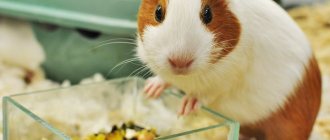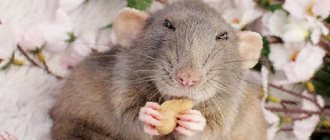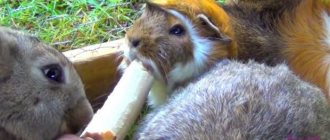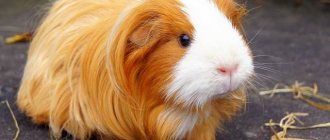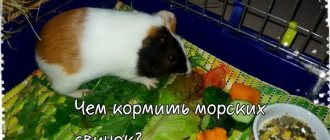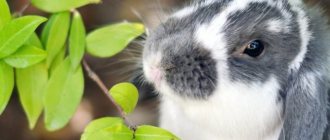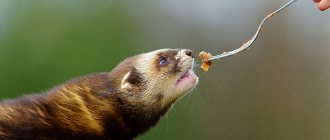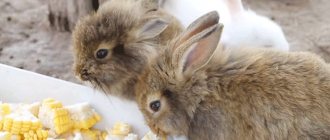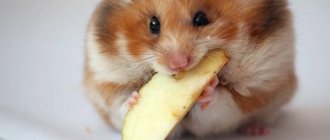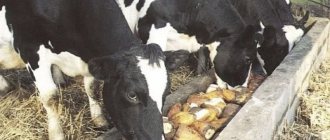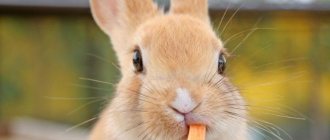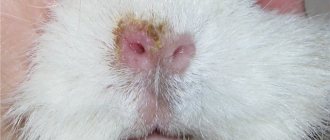- home
- Guinea pig
- Guinea pig nutrition
02/14/2019 The guinea pig is an absolute vegetarian. Greens occupy an important place in her diet. In the summer, it makes sense to completely switch the rodent to green food. First you should find out which grass is beneficial for guinea pigs and which can be harmful.
Green feed
Wild herbs, which can be picked in forest belts, along the banks of rivers, lakes, and cultivated herbs grown by humans, form the basis of the diet of rodents in the summer.
Most of the plants given to pigs can be found on the human table. But you shouldn’t focus on this. You should not give them green onions and garlic. Bay leaves, which are used by housewives as a means of adding flavor to dishes, are poisonous to guinea pigs.
The pig is given freshly picked grass or hay is prepared. In both the first and second cases, the plants must be clean and environmentally friendly. Freezing is allowed for the winter.
Some herbs can be given to guinea pigs daily (such as sedge and dill), others are given intermittently (chamomile).
What not to feed a guinea pig
There is a list of harmful foods that you should absolutely not feed to your pet guinea pig. They are absolutely useless for their body, and some of them can cause serious health problems.
What not to give to rodents:
- Prohibited vegetables: radish, radish, onion, potato, eggplant, garlic, horseradish.
- Harmful fruits: dates, persimmons, lemon, lime, pomegranates and grapefruits.
- Do not feed your pet sorrel, rhubarb greens, green onions, garlic, as well as lavender, motherwort, celandine, belladonna, serpentine, valerian, wild rosemary, fern, sow thistle and hemp seeds.
- Branches of fir, quince, oak, pine and spruce are prohibited for rodent food.
- Beans and boiled peas should not be given as legume products.
- Meat and dairy products, eggs, sweets and baked goods are prohibited in any form.
It is also unacceptable to give guinea pigs food from your table, low-quality food, spoiled and stale food, indoor greens, canned food, spices, mushrooms and fruit seeds.
The benefits of succulent feed
Each plant is endowed with a set of useful substances, which determine its benefits for the rodent:
- Snooze. It can be present in your pet’s summer diet every day. Improves digestion and enriches the body with vitamin C. It is especially useful in the spring, when you can pick young leaves of honeydew in the clearings.
- Red and white clover. Contains vitamins, proteins and essential oils, fiber. Give this herb in small portions no more than twice a week, and only on mature plants. It is contraindicated to give clover leaves to females who are carrying cubs due to the risk of miscarriage.
- Plantain is useful for rodents due to potassium, glycosides, enzymes, tannins, and vitamins. The rodent benefits from young leaves that are collected away from the highways.
- Quinoa. Contains many useful microelements. In small quantities it is beneficial. Because of oxalic acid, it is given with caution, no more than once every 2 weeks, so as not to provoke urolithiasis.
- Chamomile. It is a medicinal product, removes inflammatory processes in the body, acts as an antispasmodic and a sedative. Fresh chamomile is given to pigs once a week as a preventive measure. Decoctions are effective for stomach disorders.
- Burdock. Improves metabolism, is a storehouse of vitamins and tannins. Pigs benefit from roots and young leaves in the spring-summer season.
- Sedge. Favorite grass of rodents with a rich composition of nutrients. In spring and summer you can include it in the animal’s daily diet.
- Spinach. Rich in proteins, vitamins and potassium. In spring, animals are given fresh leaves. They can be frozen for the winter.
- Dandelion. Only leaves can be given. As a vitamin spring green, it is simply irreplaceable.
- Cilantro. Rodents have ambivalent attitudes towards this spicy greenery, which contains a rich range of beneficial microelements and vitamins. Because of its specific taste and aroma, some pets love cilantro, while others don’t even touch it. Can be included in the diet all year round.
- Iceberg lettuce. Refers to winter types of salads and can accumulate pesticides that are dangerous for pets. If grown at home, it is useful to include it in the pig's diet 2 times a week.
- Arugula. Give the rodent a limited amount due to the concentration of mustard oil. Nitrates can accumulate in the leaves.
- Coltsfoot. It belongs to medicinal plants, so it is beneficial only in limited quantities. Useful for inflammatory processes of the gastrointestinal tract and colds.
- Wheatgrass. Can be given to your pet daily. Forms the basis for hay. Improves digestion, increases appetite.
- Common wormwood. Useful for rodents. They eat it with great eagerness. Not to be confused with wormwood, which blooms with yellow flowers.
- Alfalfa. Recommended for pregnant and lactating females and young animals. Due to the large amount of calcium, adult rodents are given limited amounts.
- Woodlouse. It belongs to medicinal plants, but has no contraindications as a daily food. Boosts immunity and improves digestion.
- Mint. The tasty and aromatic herb will bring many benefits to pigs if it is introduced into the diet in doses. The problem is that not all pets tolerate it.
- Lettuce leaves are good as winter greens. Give to pets without petioles to reduce the likelihood of nitrates entering the body.
Most pigs love celery, parsley, young apple tree leaves, and fresh hay made from a collection of meadow herbs.
Forbidden herbs
There are plants that are poisonous and harmful to the body of a guinea pig:
- Avran . When eating this plant, rodents experience diarrhea, vomiting, and inflammation of the gastrointestinal mucosa. Poisoning occurs due to the presence of the poison graziolina in the juice of the plant.
- Winter meadow grass contains alkaloids that can harm the health of rodents. The vessels are the first to suffer. Lethargy, excessive salivation, bloody diarrhea, a swollen abdomen, and a decrease in temperature appear. If too much is eaten, the animal dies within two days.
- Swamp whitewing . The berries contain saponin. When they get into food, the animal develops restless behavior, drooling, and tachycardia. When dried, saponin ceases its harmful effect.
- Hemlock . Due to the content of alkaloids, it can cause poisoning of a pet. The rodent begins to have convulsions, rapid breathing and heartbeat, numbness in the hind legs, and a decrease in body temperature.
- Herbs of the ranunculaceae family, borax and aconite . The poison contained in them is also of alkaloid origin. When eating a significant amount of such plants, the animal suffers from diarrhea, salivation, shortness of breath, attacks of violent behavior, and a decrease in body temperature and pressure.
- Hemlock . Cicutotoxin causes anxiety in the behavior of animals, excessive salivation, bloating of the abdominal cavity, rapid breathing and pulse, and diarrhea. If a large amount is eaten, paralysis of the respiratory center and death occurs.
- Wild mustard . Mustard and other essential oils cause burns to the respiratory tract of animals. The mucous membranes of the gastrointestinal tract are also affected, which leads to bloating, diarrhea and colic.
- Datura . Alkaloids from the juice of the plant, entering the digestive tract, are absorbed into the blood and cause paralysis of the heart muscle and limbs.
- Cornflowers can cause vomiting, colic, diarrhea and paralysis.
- Euphorbia has a very poisonous milky juice. Causes severe inflammation of the gastrointestinal tract with vomiting and diarrhea, as well as convulsions and damage to the heart muscle.
- Digitalis causes inflammation of the gastrointestinal mucous membranes, vomiting, diarrhea, and bloating. Difficulty breathing, convulsions, weakness and tachycardia appear.
- Lumbago belongs to the ranunculaceae family. It is a poisonous plant. Can cause diarrhea, paralysis, shortness of breath, low body temperature and tachycardia.
- Wild radish . Contains a large number of essential oils. When consumed, it causes acute damage to the mucous membranes of the esophagus, stomach, oral cavity and nasopharynx.
- Hellebore . Symptoms of poisoning include convulsions, trembling, diarrhea, increased salivation, and difficulty breathing.
- Celandine . When ingested by guinea pigs, the plant causes weakness, vomiting, diarrhea, and bloating.
Where to collect
In order for the grass to benefit the rodent, you should not tear it in the following places:
- where pets can be walked;
- on pastures;
- along roads;
- near trash cans and landfills;
- close to industrial enterprises;
- in fields treated with chemicals.
You should not collect greens in forest belts and park areas where there are a large number of ticks.
It is easy to grow grass for your guinea pig in your garden. This way you can be sure of its environmental cleanliness.
Guinea pig diet
Cereals and pelleted feeds
This type of diet is based on grain crops and ready-made food, containing all the necessary vitamins and mineral supplements for the healthy growth and development of a domestic rodent.
Nutrition Features:
- You need to buy only high-quality food from trusted manufacturers for your guinea pig. Cheap food contains many harmful and unnatural ingredients that can cause serious health problems.
- Dry food must be supplemented with moist, juicy food.
- Clean drinking water should always be freely available to your pet.
- It is not advisable to feed high-calorie foods to inactive rodents.
Advantages of nutrition: ready-made food has a solid structure, which helps the animal grind its teeth, convenient use of food, no need to prepare special food for the rodent.
Disadvantages: you need to constantly purchase food for your pet and always have a certain supply of it in the house.
On our store’s website you can select and buy high-quality industrial food for domestic guinea pigs from reliable global manufacturers. The range includes cozy cages for rodents, comfortable drinking bowls, special toilets with nozzles, various accessories for games and much more.
Proper processing
Grass can be given to the rodent immediately if it is collected in clean areas. When in doubt, rinse it under running cold water.
You should not scald herbs with boiling water; this will prevent pest larvae and pathogenic bacteria from dying, and the nutritional value of the herb will decrease. The exception is nettle, which can be treated with hot water or crushed heavily so that it stops burning.
For freezing, the plants are finely chopped, placed in small batches into bags and sent to the freezer.
Determining the sex of animals
How to distinguish a male from a female guinea pig is a rather difficult question, especially when it comes to young animals and an inexperienced breeder. However, this point is important both for breeding and when purchasing mammals. Usually boys are larger than girls, but this only applies to babies of the same litter. In the store, animals can be of different ages, fatness, and the larger animal may well be a girl. You can tell more accurately whether it is a boy or a girl by examining the genitals, or more precisely, the anus. How to determine:
- you need to take the animal with your left hand and turn it belly up, with the palm of your other hand you should clasp the pig in the lumbar region, and with your thumbs gently press on the bottom of the animal’s tummy above the genitals.
When pressed, the penis is felt in boys, and the genital slit in girls.
Correct determination of sex will help to separate the cubs from their mother into cages and avoid unwanted close crossing and many other problems.
Some breeders claim that with constant observation of young animals, behavioral differences between the sexes can be noticed. Boys have a more active and playful character, and are sometimes pugnacious. Girls are calmer. Females and males can also be distinguished by their voice. Guinea pigs are very sociable animals and make a lot of sounds. The voice of females is usually thinner and quieter.
Poisonous plants
There are many plants that are poisonous to your pet and can cause death. You should not give your pig celandine, arum, henbane, rhubarb, fern, nightshade, or horse sorrel. The flowers, leaves and tubers of lily, hyacinth, lily of the valley, and narcissus are poisonous. You should not feed your pet white acacia, sorrel, broom, ivy and broom.
Not every tree or shrub is suitable for an animal. They should not be fed branches and roots of dogwood, juniper and thuja. Hellebore, oleander and belladonna are extremely dangerous for rodents. A pig can become poisoned by tasting euphorbia, aloe, or geranium.
Properties of celandine
Celandine is an inconspicuous, unpretentious weed that grows everywhere.
As already noted, it refers to poisonous plants. It contains about 20 alkaloids, which in case of overdose can be called the purest poison for the body of birds. In addition, celandine contains vitamin C, carotene, organic acids (succinic, citric, malic), biologically active compounds, essential oils, flavonoids, saponins, tannins. As a rule, all of the listed substances have healing properties to one degree or another, but mostly only when used externally.
Indeed, celandine is beneficial for the human body. But for poultry and animals it has the opposite effect. In case of overdose, the alkaloids contained in celandine can cause muscle spasms, cramps, and provoke intoxication.
Harvesting hay
Hay can be harvested from early spring until late autumn. Plants are dried under a canopy, out of direct sunlight.
In apartment conditions, an electric dryer will help out, with which you can prepare several kilograms of hay for a pig in less than 3 hours. If this is not possible, spread the grass in a thin layer on clean paper and leave to dry in a dry, ventilated place.
Freshly dried hay retains its nutritional value for up to 5 months. Dry grass smells pleasant, does not crumble into powder in your hands, and most plants retain their green color when dried.
If the hay has an unpleasant odor, it is strictly forbidden to give it to the rodent.
Contraindications for use
Considering that celandine is a poisonous herbaceous crop, it is not worth feeding chickens, as already noted, with this plant. Experienced poultry farmers know well that chickens are omnivorous birds, and they are not averse to profiting from various herbs, including poisonous ones. This, in turn, can provoke acute diarrhea, vomiting, nausea, and intoxication of the body. Therefore, most farmers agree that celandine is the purest poison for poultry.
At the same time, some poultry farmers believe that it is worth feeding chickens with various types of herbs, including celandine, but give the plant in small doses. Laying hens increase egg production. In addition, celandine improves appetite, has a pronounced antihelminthic effect, and helps improve immunity. The antihelminthic effect will increase if wormwood is fed to chickens along with celandine.
We can advise all poultry farmers who are interested in the question “Is it possible to give celandine to chickens?” don't go to extremes. This plant should not be added specifically to food. You can give laying hens and young birds a few sprigs of this herb, and then no more than once every three weeks. In addition, there are many useful plants and herbs for poultry that not only can, but also need to be added and mixed into feed.
Use in industry and agriculture
Sea greens are a feed additive for sheep, pigs, and cattle. The milk yield of cows fed a diet of sea grass increases per day by 15-20%, and fat content by 0.35%. In this case, no additional odors are detected in the milk. Poultry that feed on these plants lay more hard-shelled eggs. The use of sea grass for the production of compound feeds enriches their composition with vitamins by 40%.
Some confectionery associations use sea green pectin as a substitute for citrus extract (for marshmallows and marmalade). Also, grass from the sea allows you to make high-quality paper. It is noteworthy that such paper almost does not burn.
What to do if an animal has eaten the “forbidden fruit”?
If your pet has eaten a large amount of parsley, the body’s reaction can be very diverse. An excess of parsley can lead to various diseases, disorders, etc. First of all, it is necessary to ensure that your pet drinks plenty of fluids. And also completely eliminate parsley from your diet. If the symptoms persist, you should contact your veterinarian.
Parsley contains many beneficial substances for animals and, at the same time, can have a negative effect on their body. You should be very careful when feeding your pet this greenery and remember the dosage and its contraindications for some animals. Improper feeding can harm your pet.
If you find an error, please select a piece of text and press Ctrl+Enter.
Feeding rules
To provide your pet with a balanced diet, you need to familiarize yourself with the rules and regulations for feeding guinea pigs.
- It is advisable to feed your pet at the same time. This way he will develop a routine.
- Feed should be given little by little and fresh each time. All leftovers from the previous meal should be thrown away. It is permissible to leave only hay in the cage.
- The diet should not contain limp greens, vegetables and fruits.
- Hay, grass and greens are the basis of nutrition; guinea pigs should always have them.
- Greens, grass, vegetables and fruits should be thoroughly washed. There is no need to peel fruits and vegetables.
- Water for guinea pigs should always be clean and should be changed once a day.
- In order for guinea pigs to grind their teeth, they need to be given tree branches: willow, ash, alder, apple, pear, linden, birch.
Tree branches
Twigs, leaves and any other parts of the following trees are contraindicated for guinea pigs: cypress, yew, holly, thuja, robinia, buckthorn.
The pet is also not allowed to eat acorns, nuts and chestnuts, but is allowed to try the branches of these trees from time to time. In small quantities they will not cause harm.
What drinks can you give your guinea pig?
Just remember that it is safe for pigs to drink only plain, clean water. Bitter, sweet, carbonated and alcoholic drinks are prohibited. At best, they will cause severe stomach upset, and at worst, the death of the pet.
How to process correctly
It is important to know not only what grass can be given to pet rodents, but also how to process it correctly. Grass collected in the ecozone does not need to be washed. It is worth remembering that water only washes away the remaining dust, but does not eliminate the toxic substances that the greenery has absorbed.
It is strictly forbidden to process green food with boiling water. Heat-treated herbs should not be fed to these animals. Some breeders believe that in this way they can destroy parasite eggs, but this is deeply misleading. It is impossible to destroy them by heat treatment.
Article on the topic: Can guinea pigs eat black or white bread?
In addition, heat treatment of greens makes it absolutely useless for the animal’s body, since under such influence all useful substances are destroyed.
It is not recommended to give a lot of fresh greens after wintering. An animal that is not accustomed to succulent food may get sick. Most often this provokes gastrointestinal upset, diarrhea and vomiting.
Results
Each rodent has its own preferences, which every owner should be aware of. When offering your pet different greens, you need to observe his reaction. Some herbs can cause allergies. Therefore, the first time the new grass is offered to the pig separately.
Guinea pigs eat grass with great pleasure. For them, this is tasty and healthy food that increases immunity and stamina, heals the body, and therefore prolongs the life of the pet.
Consumer Reviews
Many buyers leave grateful reviews after purchasing furniture filled with sea grass. People note that this plant has a healing and antibacterial effect because it releases iodine. Sleeping on orthopedic damask mattresses charges you with energy for the whole day. This is a kind of natural latex, which is obtained by impregnating and bonding ocean grass. Mattresses made from this material have a light massage and soothing effect, regulate the balance of humidity and temperature of the sleeper.
